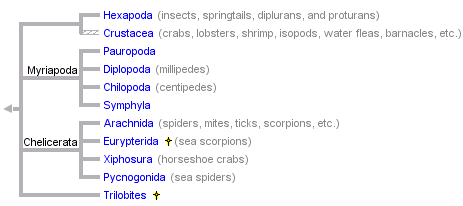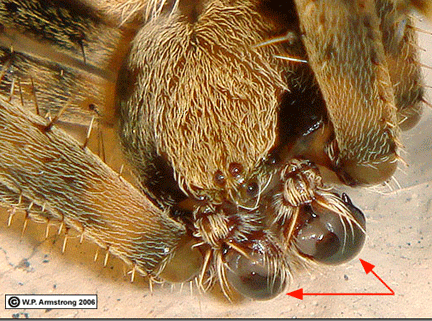
Types of Arthropods
We will continue in lab exercises and at times in lecture adding to our knowledge of arthropods. For now we simply introduce the groups based on traditional distinctions.

Traditionally. placing arthropods into groups was based on tagmata or how segments are divided into functional units. Now we also use molecular relationships. Body of primitive forms is homonomous (all body segments are very similar), but in vast majority there is some degree of tagmatization (specialization and fusion of joints). Ancestrally limbs seem to be biramous: one branch for locomotion, the other branch being a gill. Various derived forms lose the gills to become uniramous. Generally chelicerates, myriapods and insects have uniramous limbs, while crustaceans and trilobites have biramous limbs. Limbs of major groups of arthropods also show characteristic numbers, morphologies and functions.
Trilobites; An extinct clade
Anterior-posterior burrows divide the body into 3 regions (two lateral, one central).
Examine the material on trilobite relative success
http://evolution.berkeley.edu/evolibrary/article/_0_0/success_02
Eurypterida: An extinct clade
This clade includes giant sea scorpions and are considered part of Arachnida by some, a separate clade by others.
Merostomata or Xiphosura
Appendages on the abdomen (opisthosoma) are flattened and modified for gas exchange as "book gills". The terminal portion of body (telson) drawn out into an elongated spike.
Horseshoe crabs are considered to be living fossils. Limulus, a genus found along the east coast of North America, has remained relatively unchanged since the Triassic Period about 220 million years ago. The North American species migrate to shallow water in the spring, then mate at night during high tide.
Horseshoe crabs feed on the sea bottom, capturing small molluscs and worms with their pincers. They break up hard material, such as mollusc shells, by grinding it between the hard edges of their upper legs or the gnathobases. Chelicera, small degenerate legs, located behind the pusher legs, can push any food into the crab's mouth. A horseshoe crab also has a gizzard that contains sand and small bits of gravel to help grind its food.
On the site, also explore protecting health. In this age of Covid, the importance of horseshoe crabs to us cannot be overemphasized.
https://www.youtube.com/watch?v=CgRn3T7vcMw
The material made from horseshoe crab blood costs $60,000 a gallon. Here is a more recent article on the use of horseshoe crab blood which puts the number of crabs that might die every year from bleeding at 30%. Debate continues about the use of synthetics.
https://www.nationalgeographic.com/animals/2020/07/covid-vaccine-needs-horseshoe-crab-blood/
Pycnogonida (sea spiders)
They lack body tagmata and have a very unique proboscis at the anterior end. They may have a variable number of walking legs. The digestive system extends into the legs, and the pair of simple eyes are positioned near the end of the trunk. Sea spiders are carnivorous, some feeding on other invertebrates by sucking out the juices, while others tear their prey apart and pass it into the proboscis for feeding. Males often care for eggs.
Most sea spiders are 1 to 10 mms in length but some deepwater species in Antarctica can have a leg span up to 90 cms!
Myriapoda: centipedes and millipedes
Appendages on the third head segment are modified as mandible for chewing or grinding food. Retinula of compound eye contains eight cells.
The myriapods are divided into the centipedes which are active predators and the millipedes which eat plant material. Centipedes have pair of poison claws behind the head, (modified first pair of thoracic legs) and use the poison to paralyze their prey, usually small insects. Land animals, they like insects utilize trachea for respiration.
Centipedes and millipedes mate in the manner typical of many arthropods -- the male produces a packet of sperm called a spermatophore, which is taken up by the female and stored in a pair of internal sacs known as spermathecae, where the sperm is used to fertilize her eggs.
Possibly the oldest known terrestrial air-breathing organism is the millipede Pneumodesmus newmani from the mid Silurian dating to about 425 million years. It exhibits cuticular openings that taxonomists have interpreted as spiracles.
Two small groups, Pauropoda and Symphyla, about 1.5 or 1-8 mm in length are also included in this clade. In the first case, group is identified by distinctive antennae, in the second case, specimens look like tiny centipedes.
http://en.wikipedia.org/wiki/Symphyla
Arachnids
Large arachnids typically have only two body regions—the cephalothorax and the abdomen. Spiders, scorpions, mites, and ticks are typical arachnids. Smaller ticks and mites may only have one body segment. Arachnids have six pairs of jointed appendages.
An example, the typical spider. The first pair of appendages, called chelicerae, is located near the mouth. Chelicerae are often modified into pincers or fangs. The second pair of appendages is called the pedipalps. In male spiders, pedipalps deliver sperm to the female. The four remaining appendages in arachnids are adapted as legs. All true spiders spin silk. Spider silk is secreted by silk glands in the abdomen. As silk is secreted, it is spun into thread by structures called spinnerets, located at the rear of the spider.

There are some species dangerous to man.
Brown recluse and black widow spiders.
Much of the basic research on true spiders focuses on their mating dances.
Many spiders produce vibrations on female webs as part of courtship. Others combine the production of vibration with the movement of legs and other parts of the body in a type of "dance" that is species specific. https://www.youtube.com/watch?v=y7qMqAgCqME
Probably most notable among dancing spiders is the peacock spider.
https://www.youtube.com/watch?v=5qkzwG2lLPc
A short video showing all the different dances of the peacock spider.
https://www.youtube.com/watch?v=HPh_Gi7PCqs
We will take a look at other members of this group later in the courseCrustacea
Crustaceans are the only arthropods that have two or more pairs of antennae for sensing. They have at least two major body tagmata. All crustaceans have mandibles for crushing food. Crustaceans have appendages modified for a variety of function. http://evolution.berkeley.edu/evolibrary/article/0_0_0/success_06
Hexapoda
The Clade is the largest group of eukaryotes and there are at least three times as many species of insects as there are all other kinds of animals combined. No one knows exactly how many kinds there are, as many previously unknown species are being discovered each year.
Characteristics include fusion of one pair of head appendages (the second maxillae to form a lower lip (the labrum) and loss of abdominal appendages. There is a pair of antennae and a pair of compound eyes. There generally are three body segments and six legs.
There are three small groups of Hexapods that are believed to have branched off an ancestor before the evolution of insects. in these groups, the mouthparts are located inside a pouch and are not visible externally.
All are small, with the most common encountered being springtails or Collembola. The ventral tube can secrete adhesive, but is mainly used to transfer water to various parts of the body. The furcula is used for jumping.
We will be featuring species of insects and crustaceans thoughout the course, especially in lab exercises.
.